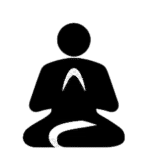Shamatha Meditation Exercise
Shamatha meditation is a form of meditation that focuses on working with your attention. Shamatha is also called ‘calm abiding’ meditation, is a meditation that works with your attention, a mindfulness meditation.
A nice instruction is given in the video by David Nichtern (see also: http://davidnichtern.com/meditation/ )
Attitude
Before you start a meditation it is good to be aware of your posture with which you will meditate. In your meditation it is the intention that your spine is really straight and that your breathing can take place unimpeded.
I sometimes pretend there is a string on my crown and in my imagination I gently straighten my spine with it… everything in line with each other.
To sit
It sits itself. You sit down. Whether sitting in a tailor, in a more formal position, or simply on a chair. You ensure that you are well supported. This can be done by a straight, balanced posture, but also, for example, if you are sitting in a chair by putting a pillow in your back or putting your feet on a footstool, for example.
By tilting your hips slightly, and moving your chin a little downwards (towards your neck), you will feel how you can sit upright, which creates more balance and space in your body for your breathing.
Your shoulders relax, and you let your hands fall freely next to your body and then place them on your thighs. Relax everything.
When you sit correctly, it seems as if your body is supporting itself.
Breathing
Now that you have sat down with attention and felt and positioned your body, let your attention slide down your body. Along your feet, legs, hands, arms, torso and come to your breathing. Feel how you breathe in regularly, there is a little pause, you breathe out again, there is a little moment before you breathe in again, you breathe in again and so on. If possible, breathe in through your nose and out through a relaxed and slightly opened mouth or through your nose. You can feel your breath go through your nostrils.
There is no right or wrong way to feel your breath. You just feel where you perceive your breathing.
Attention
And as you sit, focus your attention on your breathing and on your body. Nothing special. A child can do the laundry.
But then it quickly becomes more of a challenge. Because you keep your attention on both your body and your breathing. And that soon turns out to be a lot more difficult than doing the laundry!
You are now in mindfulness meditation, attention in your body and on your breathing.
Thoughts
And then it happens…. as you breathe mindfully and perceive your breath, thoughts arise and take you away with your attention. Oops ..
Nothing you can do. We are human beings, so we think. So just carried away by your thoughts. But because you are aware that this is happening, it is also easy to simply return your attention from your thoughts to your breathing. And do it in a gentle way, so with the awareness that this is what happens and is not bad (and certainly does not make you better or worse than if it didn’t happen).
Gentleness and discipline
Now, if you don’t immediately manage to redirect your thoughts like that, you can become very frustrated and that is not the purpose of your meditation. So stay gentle with yourself, not painfully strict but with gentle discipline. In the beginning of the meditation it is mainly about making a rhythm, a usual pattern for yourself to go into your meditation. How long you do it and whether or not you have immediate success (whatever that is!) Is much less important. For example, you can start with 5 or 10 minutes to start.
When you then bring your attention back to your breathing, you also think about your posture and the feeling in your body, how your body is still relaxed, with space in it.
End
When you are done with your meditation you end by slowly opening your eyes again, or calmly bringing your gaze back up and into focus on your surroundings. Get up slowly, paying attention to how your body feels. If you find that your legs have gone to sleep, take a moment to get the blood circulation going again in them so that you can get up again… without the risk of falling.

